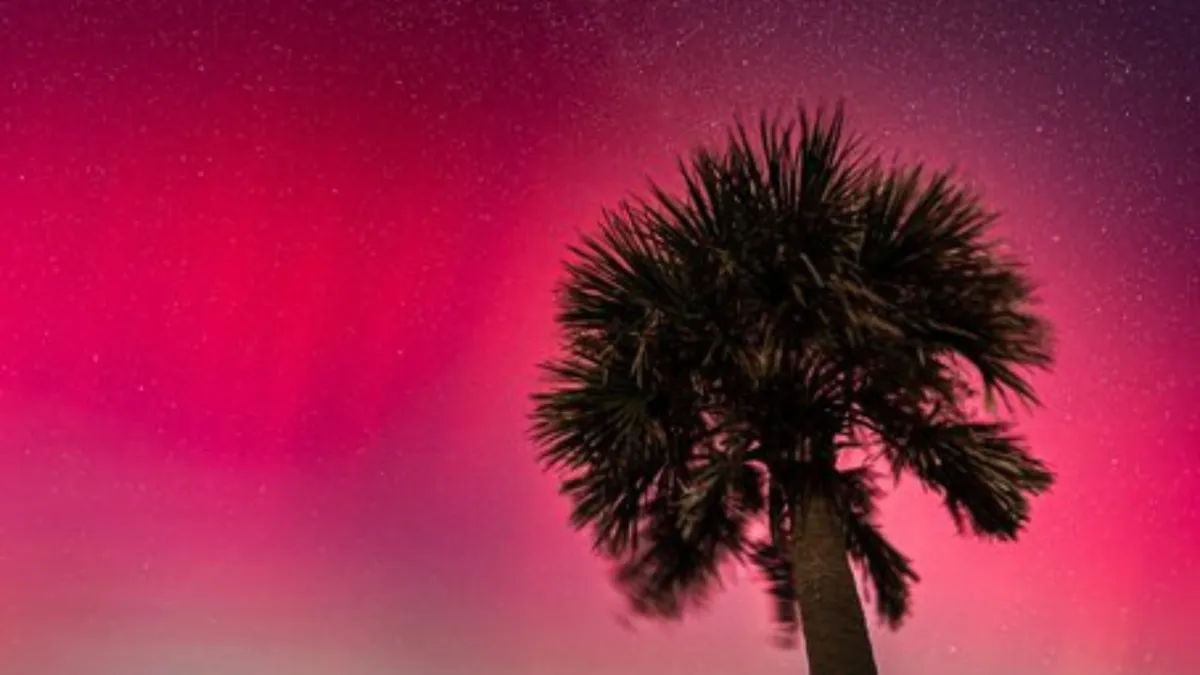| Summary |
|
A powerful solar flare triggered a major geomagnetic storm that reached G4 intensity. The event pushed auroras far beyond their usual range, giving many regions a rare chance to see the lights. Operators monitored satellites, navigation signals, and power grids because storms of this level can disrupt technology.
A powerful solar storm lit up the skies across North America this week, painting them in shades of green and purple visible as far south as Florida. The G4-class geomagnetic storm, one of the strongest of 2025 so far, was triggered by a massive burst of energy from the Sun on November 11, reported NOAA.
The event began when an intense solar flare erupted from an active region on the Sun’s surface. These flares occur when tangled magnetic fields suddenly snap and release large amounts of energy. This eruption sent a coronal mass ejection, or CME, racing toward Earth at millions of miles per hour.
When it struck on November 12, the blast compressed Earth’s magnetic field, creating a G4-level geomagnetic storm. On NOAA’s five-point scale, G5 is the most severe, and G4 is enough to cause strong magnetic disturbances and widespread auroras.
How does an aurora form? When charged particles from the Sun collide with gases in Earth’s upper atmosphere, they emit light. Oxygen produces green glows at lower altitudes, while nitrogen creates red and purple tones higher up. During this storm, the intense solar wind pushed the auroral oval much farther south than usual.
People from Alaska to Wisconsin captured striking photos of crimson and emerald bands moving across the sky, while residents in Florida reported pink streaks over the Gulf Coast.

Among those lucky enough to see the spectacle was Ryan Hall, a digital meteorologist known online as “The Weather Man.” While flying over Michigan with his wife, he saw the aurora spread beneath the aircraft like a glowing river. He shared photos and videos with his followers on X, describing the experience as a once-in-a-lifetime sight. The clips showed how the aurora shifted in real time, changing from a calm green glow to bright, flickering waves.
That’s a wrap on chasing auroras at 25,000 feet! What an absolutely awesome experience. A total bucket list item checked off, and I got to experience it all with my wife. You just have to love science! pic.twitter.com/8gpFmztsQf
— Ryan Hall, Y’all (@ryanhallyall) November 13, 2025
Despite the storm’s intensity, no major blackouts or satellite failures were reported. Geomagnetic storms of this strength can interfere with navigation systems, GPS, and radio communications, and airlines sometimes reroute polar flights to avoid high radiation exposure. NOAA’s Space Weather Prediction Center monitored the situation closely and provided alerts to help operators prepare for potential issues.
The storm arrived during the peak of the Sun’s 11-year activity cycle, known as solar maximum. This is when sunspots, flares, and CMEs become more frequent and powerful. The last major solar storm of this scale happened in 2012, and scientists say the current level of solar activity is similar to the period leading up to the 1989 Quebec blackout.
More solar eruptions launched earlier in November could still reach Earth, meaning auroras may continue over the coming days. Space weather experts recommend checking aurora forecast apps and heading to dark, open areas for the best view.
For many, the November 2025 storm will be remembered as one of the most spectacular sky shows in years a vivid reminder of how closely our planet’s magnetic shield is connected to the changing moods of the Sun.

